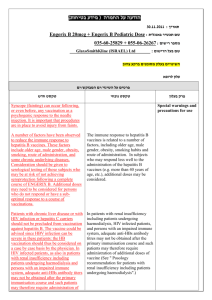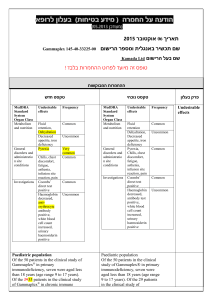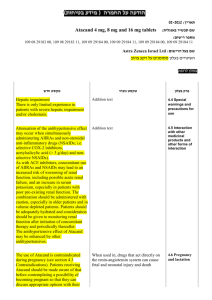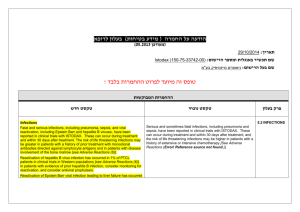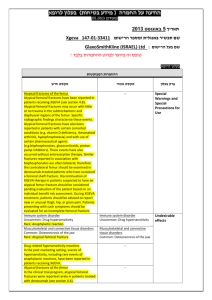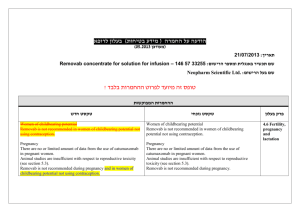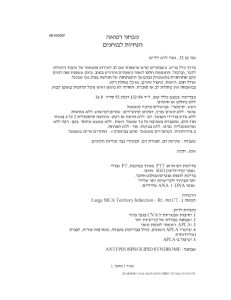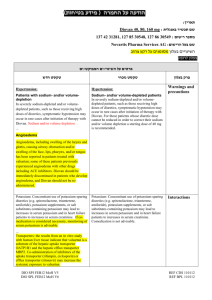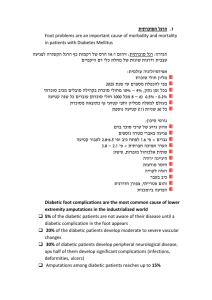opdivo
advertisement
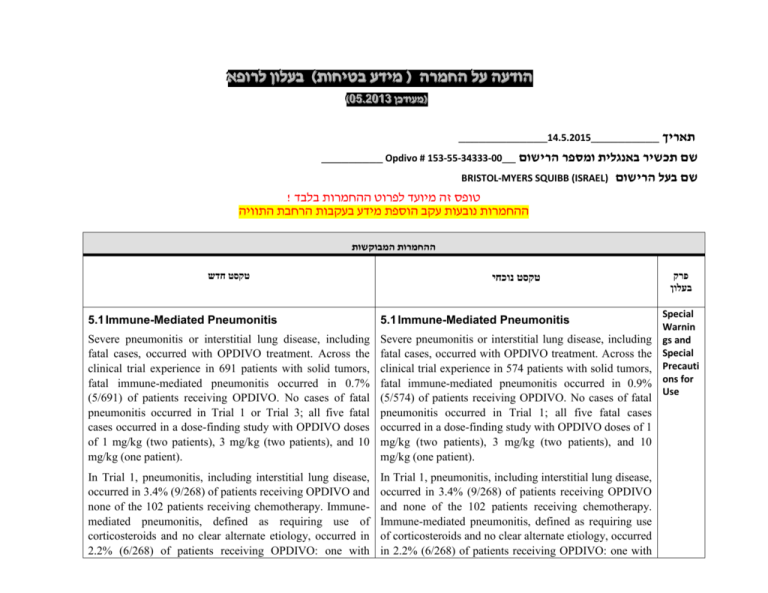
רופא בעלון ללרופא בטיחות)) בעלון מידע בטיחות החמרה (( מידע על החמרה הודעה על הודעה ))05.2013 05.2013 מעודכן ((מעודכן _____________14.5.2015__________ תאריך _________ Opdivo # 153-55-34333-00__ שם תכשיר באנגלית ומספר הרישום BRISTOL-MYERS SQUIBB (ISRAEL) שם בעל הרישום ! טופס זה מיועד לפרוט ההחמרות בלבד ההחמרות נובעות עקב הוספת מידע בעקבות הרחבת התוויה ההחמרות המבוקשות טקסט חדש טקסט נוכחי Special Warnin Severe pneumonitis or interstitial lung disease, including gs and fatal cases, occurred with OPDIVO treatment. Across the Special clinical trial experience in 574 patients with solid tumors, Precauti fatal immune-mediated pneumonitis occurred in 0.9% ons for Use 5.1 Immune-Mediated Pneumonitis 5.1 Immune-Mediated Pneumonitis Severe pneumonitis or interstitial lung disease, including fatal cases, occurred with OPDIVO treatment. Across the clinical trial experience in 691 patients with solid tumors, fatal immune-mediated pneumonitis occurred in 0.7% (5/691) of patients receiving OPDIVO. No cases of fatal pneumonitis occurred in Trial 1 or Trial 3; all five fatal cases occurred in a dose-finding study with OPDIVO doses of 1 mg/kg (two patients), 3 mg/kg (two patients), and 10 mg/kg (one patient). (5/574) of patients receiving OPDIVO. No cases of fatal pneumonitis occurred in Trial 1; all five fatal cases occurred in a dose-finding study with OPDIVO doses of 1 mg/kg (two patients), 3 mg/kg (two patients), and 10 mg/kg (one patient). In Trial 1, pneumonitis, including interstitial lung disease, occurred in 3.4% (9/268) of patients receiving OPDIVO and none of the 102 patients receiving chemotherapy. Immunemediated pneumonitis, defined as requiring use of corticosteroids and no clear alternate etiology, occurred in 2.2% (6/268) of patients receiving OPDIVO: one with פרק בעלון In Trial 1, pneumonitis, including interstitial lung disease, occurred in 3.4% (9/268) of patients receiving OPDIVO and none of the 102 patients receiving chemotherapy. Immune-mediated pneumonitis, defined as requiring use of corticosteroids and no clear alternate etiology, occurred in 2.2% (6/268) of patients receiving OPDIVO: one with Grade 3 and five with Grade 2 pneumonitis. The median time to onset for the six cases was 2.2 months (range: 25 days to 3.5 months). In two patients, pneumonitis was diagnosed after discontinuation of OPDIVO for other reasons, and Grade 2 pneumonitis led to interruption or permanent discontinuation of OPDIVO in the remaining four patients. All six patients received high-dose corticosteroids (at least 40 mg prednisone equivalents per day); immune-mediated pneumonitis improved to Grade 0 or 1 with corticosteroids in all six patients. There were two patients with Grade 2 pneumonitis that completely resolved (defined as complete resolution of symptoms with completion of corticosteroids) and OPDIVO was restarted without recurrence of pneumonitis. Grade 3 and five with Grade 2 pneumonitis. The median time to onset for the six cases was 2.2 months (range: 25 days-3.5 months). In two patients, pneumonitis was diagnosed after discontinuation of OPDIVO for other reasons, and Grade 2 pneumonitis led to interruption or permanent discontinuation of OPDIVO in the remaining four patients. All six patients received high-dose corticosteroids (at least 40 mg prednisone equivalents per day); immune-mediated pneumonitis improved to Grade 0 or 1 with corticosteroids in all six patients. There were two patients with Grade 2 pneumonitis that completely resolved (defined as improved to Grade 0 with completion of corticosteroids) and OPDIVO was restarted without recurrence of pneumonitis. In Trial 3, pneumonitis occurred in 6% (7/117) of patients receiving OPDIVO, including five Grade 3 and two Grade 2 cases, all immune-mediated. The median time to onset was 3.3 months (range: 1.4 to 13.5 months). All seven patients discontinued OPDIVO for pneumonitis or another event and all seven patients experienced complete resolution of pneumonitis following receipt of high-dose corticosteroids (at least 40 mg prednisone equivalents per day). Monitor patients for signs and symptoms of pneumonitis. Administer corticosteroids at a dose of 1 to 2 mg/kg/day prednisone equivalents for Grade 2 or greater pneumonitis, followed by corticosteroid taper. Permanently discontinue OPDIVO for severe (Grade 3) or life-threatening (Grade 4) pneumonitis and withhold OPDIVO until resolution for moderate (Grade 2) pneumonitis [see Dosage and Administration (2.2)]. Monitor patients for signs and symptoms of pneumonitis. Administer corticosteroids at a dose of 1 to 2 mg/kg/day prednisone equivalents for Grade 2 or greater pneumonitis, followed by corticosteroid taper. Permanently discontinue OPDIVO for severe (Grade 3) or life-threatening (Grade 4) pneumonitis and withhold OPDIVO until resolution for moderate (Grade 2) pneumonitis [see Dosage and Administration (2.2)]. 5.2 Immune-Mediated Colitis 5.2 Immune-Mediated Colitis In Trial 1, diarrhea or colitis occurred in 21% (57/268) of patients receiving OPDIVO and 18% (18/102) of patients receiving chemotherapy. Immune-mediated colitis, defined as requiring use of corticosteroids with no clear alternate etiology, occurred in 2.2% (6/268) of patients receiving OPDIVO: five patients with Grade 3 and one patient with Grade 2 colitis. The median time to onset of immune-mediated colitis from initiation of OPDIVO was 2.5 months (range: 1-6 months). In three patients, colitis In Trial 1, diarrhea or colitis occurred in 21% (57/268) of patients receiving OPDIVO and 18% (18/102) of patients receiving chemotherapy. Immune-mediated colitis, defined as requiring use of corticosteroids with no clear alternate etiology, occurred in 2.2% (6/268) of patients receiving OPDIVO: five patients with Grade 3 and one patient with Grade 2 colitis. The median time to onset of immunemediated colitis from initiation of OPDIVO was 2.5 months (range: 1 to 6 months). In three patients, colitis was diagnosed after discontinuation of OPDIVO for other reasons, and Grade 2 or 3 colitis led to interruption or permanent discontinuation of OPDIVO in the remaining three patients. Five of these six patients received high-dose corticosteroids (at least 40 mg prednisone equivalents) for a median duration of 1.4 months (range: 3 days to 2.4 months) preceding corticosteroid taper. The sixth patient continued on low-dose corticosteroids started for another immune-mediated adverse reaction. Immune-mediated colitis improved to Grade 0 with corticosteroids in five patients, including one patient with Grade 3 colitis retreated after complete resolution (defined as improved to Grade 0 with completion of corticosteroids) without additional events of colitis. Grade 2 colitis was ongoing in one patient. In Trial 3, diarrhea occurred in 21% (24/117) of patients. Immune-mediated colitis (Grade 3) occurred in 0.9% (1/117) of patients. The time to onset in this patient was 6.7 months. The patient received high-dose corticosteroids and was permanently discontinued from OPDIVO. Complete resolution occurred. was diagnosed after discontinuation of OPDIVO for other reasons, and Grade 2 or 3 colitis led to interruption or permanent discontinuation of OPDIVO in the remaining three patients. Five of these six patients received highdose corticosteroids (at least 40 mg prednisone equivalents) for a median duration of 1.4 months (range: 3 days-2.4 months) preceding corticosteroid taper. The sixth patient continued on low-dose corticosteroids started for another immune-mediated adverse reaction. Immunemediated colitis improved to Grade 0 with corticosteroids in five patients, including one patient with Grade 3 colitis retreated after complete resolution (defined as improved to Grade 0 with completion of corticosteroids) without additional events of colitis. Grade 2 colitis was ongoing in one patient. Monitor patients for immune-mediated colitis. Administer corticosteroids at a dose of 1 to 2 mg/kg/day prednisone equivalents followed by corticosteroid taper for severe (Grade 3) or life-threatening (Grade 4) colitis. Administer corticosteroids at a dose of 0.5 to 1 mg/kg/day prednisone equivalents followed by corticosteroid taper for moderate (Grade 2) colitis of more than 5 days duration; if worsening or no improvement occurs despite initiation of corticosteroids, increase dose to 1 to 2 mg/kg/day prednisone equivalents. Withhold OPDIVO for Grade 2 or 3 immune-mediated colitis. Permanently discontinue OPDIVO for Grade 4 colitis or for recurrent colitis upon restarting OPDIVO [see Dosage and Administration (2.2)]. Monitor patients for immune-mediated colitis. Administer 5.3 Immune-Mediated Hepatitis corticosteroids at a dose of 1 to 2 mg/kg/day prednisone In Trial 1, there was an increased incidence of liver test equivalents followed by corticosteroid taper for severe abnormalities in the OPDIVO-treated group as compared (Grade 3) or life-threatening (Grade 4) colitis. Administer corticosteroids at a dose of 0.5 to 1 mg/kg/day prednisone equivalents followed by corticosteroid taper for moderate (Grade 2) colitis of more than 5 days duration; if worsening or no improvement occurs despite initiation of corticosteroids, increase dose to 1 to 2 mg/kg/day prednisone equivalents. Withhold OPDIVO for Grade 2 or 3 immune-mediated colitis. Permanently discontinue OPDIVO for Grade 4 colitis or for recurrent colitis upon restarting OPDIVO [see Dosage and Administration (2.2)]. 5.3 Immune-Mediated Hepatitis In Trial 1, there was an increased incidence of liver test abnormalities in the OPDIVO-treated group as compared to the chemotherapy-treated group, with increases in AST (28% vs. 12%), alkaline phosphatase (22% vs. 13%), ALT (16% vs. 5%), and total bilirubin (9% vs. 0). Immunemediated hepatitis, defined as requirement for corticosteroids and no clear alternate etiology, occurred in 1.1% (3/268) of patients receiving OPDIVO: two patients with Grade 3 and one patient with Grade 2 hepatitis. The time to onset was 97, 113, and 86 days after initiation of OPDIVO. In one patient, hepatitis was diagnosed after discontinuation of OPDIVO for other reasons. In two patients, OPDIVO was withheld. All three patients received high-dose corticosteroids (at least 40 mg prednisone equivalents). Liver tests improved to Grade 1 within 4 to 15 days of initiation of corticosteroids. Immune-mediated hepatitis resolved and did not recur with continuation of corticosteroids in two patients; the third patient died of disease progression with persistent hepatitis. The two patients with Grade 3 hepatitis that resolved restarted OPDIVO and, in one patient, Grade 3 immune-mediated to the chemotherapy-treated group, with increases in AST (28% vs. 12%), alkaline phosphatase (22% vs. 13%), ALT (16% vs. 5%), and total bilirubin (9% vs. 0). Immune-mediated hepatitis, defined as requirement for corticosteroids and no clear alternate etiology, occurred in 1.1% (3/268) of patients receiving OPDIVO: two patients with Grade 3 and one patient with Grade 2 hepatitis. The time to onset was 97, 113, and 86 days after initiation of OPDIVO. In one patient, hepatitis was diagnosed after discontinuation of OPDIVO for other reasons. In two patients, OPDIVO was withheld. All three patients received high-dose corticosteroids (at least 40 mg prednisone equivalents). Liver tests improved to Grade 1 within 4-15 days of initiation of corticosteroids. Immunemediated hepatitis resolved and did not recur with continuation of corticosteroids in two patients; the third patient died of disease progression with persistent hepatitis. The two patients with Grade 3 hepatitis that resolved restarted OPDIVO and, in one patient, Grade 3 immune-mediated hepatitis recurred resulting in permanent discontinuation of OPDIVO. Monitor patients for abnormal liver tests prior to and periodically during treatment. Administer corticosteroids at a dose of 1 to 2 mg/kg/day prednisone equivalents for Grade 2 or greater transaminase elevations, with or without concomitant elevation in total bilirubin. Withhold OPDIVO for moderate (Grade 2) and permanently discontinue OPDIVO for severe (Grade 3) or lifethreatening (Grade 4) immune-mediated hepatitis [see Dosage and Administration (2.2) and Adverse Reactions (6.1)]. 5.4 Immune-Mediated Nephritis and Renal hepatitis recurred resulting in permanent discontinuation of Dysfunction OPDIVO. In Trial 1, there was an increased incidence of elevated In Trial 3, the incidences of increased liver test values were creatinine in the OPDIVO-treated group as compared to AST (16%), alkaline phosphatase (14%), ALT (12%), and the chemotherapy-treated group (13% vs. 9%). Grade 2 or total bilirubin (2.7%). No cases of immune-mediated 3 immune-mediated nephritis or renal dysfunction (defined as Grade 2 increased creatinine, requirement hepatitis occurred in this trial. for corticosteroids, and no clear alternate etiology) Monitor patients for abnormal liver tests prior to and occurred in 0.7% (2/268) of patients at 3.5 and 6 months periodically during treatment. Administer corticosteroids at after OPDIVO initiation, respectively. OPDIVO was a dose of 1 to 2 mg/kg/day prednisone equivalents for Grade permanently discontinued in both patients; both received 2 or greater transaminase elevations, with or without high-dose corticosteroids (at least 40 mg prednisone concomitant elevation in total bilirubin. Withhold OPDIVO equivalents). Immune-mediated nephritis resolved and did for moderate (Grade 2) and permanently discontinue not recur with continuation of corticosteroids in one OPDIVO for severe (Grade 3) or life-threatening (Grade 4) patient. Renal dysfunction was ongoing in one patient. immune-mediated hepatitis [see Dosage and Administration Monitor patients for elevated serum creatinine prior to (2.2) and Adverse Reactions (6.1)]. and periodically during treatment. Administer 5.4 Immune-Mediated Nephritis and Renal corticosteroids at a dose of 1 to 2 mg/kg/day prednisone Dysfunction equivalents followed by corticosteroid taper for lifeIn Trial 1, there was an increased incidence of elevated threatening (Grade 4) serum creatinine elevation and creatinine in the OPDIVO-treated group as compared to the permanently discontinue OPDIVO. For severe (Grade 3) chemotherapy-treated group (13% vs. 9%). Grade 2 or 3 or moderate (Grade 2) serum creatinine elevation, immune-mediated nephritis or renal dysfunction (defined as withhold OPDIVO and administer corticosteroids at a Grade 2 increased creatinine, requirement for dose of 0.5 to 1 mg/kg/day prednisone equivalents corticosteroids, and no clear alternate etiology) occurred in followed by corticosteroid taper; if worsening or no 0.7% (2/268) of patients at 3.5 and 6 months after OPDIVO improvement occurs, increase dose of corticosteroids to 1 initiation, respectively. OPDIVO was permanently to 2 mg/kg/day prednisone equivalents and permanently discontinued in both patients; both received high-dose discontinue OPDIVO [see Dosage and Administration corticosteroids (at least 40 mg prednisone equivalents). (2.2) and Adverse Reactions (6.1)]. Immune-mediated nephritis resolved and did not recur with continuation of corticosteroids in one patient. Renal 5.5 Immune-Mediated Hypothyroidism and Hyperthyroidism dysfunction was ongoing in one patient. In Trial 1, where patients were evaluated at baseline and In Trial 3, the incidence of elevated creatinine was 22%. Immune-mediated renal dysfunction (Grade 2) occurred in 0.9% (1/117) of patients. The time to onset in this patient was 0.8 months. The patient received high-dose corticosteroids. OPDIVO was withheld, and the patient discontinued due to disease progression prior to receiving additional OPDIVO. Immune-mediated renal dysfunction was ongoing. Monitor patients for elevated serum creatinine prior to and periodically during treatment. Administer corticosteroids at a dose of 1 to 2 mg/kg/day prednisone equivalents followed by corticosteroid taper for life-threatening (Grade 4) serum creatinine elevation and permanently discontinue OPDIVO. For severe (Grade 3) or moderate (Grade 2) serum creatinine elevation, withhold OPDIVO and administer corticosteroids at a dose of 0.5 to 1 mg/kg/day prednisone equivalents followed by corticosteroid taper; if worsening or no improvement occurs, increase dose of corticosteroids to 1 to 2 mg/kg/day prednisone equivalents and permanently discontinue OPDIVO [see Dosage and Administration (2.2) and Adverse Reactions (6.1)]. during the trial for thyroid function, Grade 1 or 2 hypothyroidism occurred in 8% (21/268) of patients receiving OPDIVO and none of the 102 patients receiving chemotherapy. The median time to onset was 2.5 months (range: 24 days-11.7 months). Seventeen of the 21 patients with hypothyroidism received levothyroxine. Fifteen of 17 patients received subsequent OPDIVO dosing while continuing to receive levothyroxine. Grade 1 or 2 hyperthyroidism occurred in 3% (8/268) of patients receiving OPDIVO and 1% (1/102) of patients receiving chemotherapy. The median time to onset in OPDIVO-treated patients was 1.6 months (range: 0-3.3 months). Four of five patients with Grade 1 hyperthyroidism and two of three patients with Grade 2 hyperthyroidism had documented resolution of hyperthyroidism; all three patients received medical management for Grade 2 hyperthyroidism. Monitor thyroid function prior to and periodically during treatment. Administer hormone replacement therapy for hypothyroidism. Initiate medical management for control of hyperthyroidism. There are no recommended dose 5.5 Immune-Mediated Hypothyroidism and Hyperthyroidism adjustments of OPDIVO for hypothyroidism or In Trial 1, where patients were evaluated at baseline and hyperthyroidism. during the trial for thyroid function, Grade 1 or 2 5.6 Other Immune-Mediated Adverse Reactions hypothyroidism occurred in 8% (21/268) of patients Other clinically significant immune-mediated adverse receiving OPDIVO and none of the 102 patients receiving reactions can occur. Immune-mediated adverse reactions chemotherapy. The median time to onset was 2.5 months may occur after discontinuation of OPDIVO therapy. (range: 24 days to 11.7 months). Seventeen of the 21 patients with hypothyroidism received levothyroxine. The following clinically significant, immune-mediated Fifteen of 17 patients received subsequent OPDIVO dosing adverse reactions occurred in less than 1% of OPDIVOtreated patients in Trial 1: pancreatitis, uveitis, while continuing to receive levothyroxine. demyelination, autoimmune neuropathy, adrenal Grade 1 or 2 hyperthyroidism occurred in 3% (8/268) of patients receiving OPDIVO and 1% (1/102) of patients receiving chemotherapy. The median time to onset in OPDIVO-treated patients was 1.6 months (range: 0 to 3.3 months). Four of five patients with Grade 1 hyperthyroidism and two of three patients with Grade 2 hyperthyroidism had documented resolution of hyperthyroidism; all three patients received medical management for Grade 2 hyperthyroidism. In Trial 3, patients were evaluated for thyroid function at baseline, first day of treatment, and every 6 weeks. Hypothyroidism occurred in 4.3% (5/117) of patients. The median time to onset for these five cases was 4.1 months (range: 1.4 to 4.6 months). All five patients with hypothyroidism received levothyroxine. Complete resolution of hypothyroidism occurred in one patient allowing discontinuation of levothyroxine. Interruption of OPDIVO did not occur in these five patients. Hyperthyroidism occurred in 1.7% (2/117) of patients. One patient experienced Grade 2 hyperthyroidism 5.2 months after the first dose of OPDIVO, requiring treatment with high-dose corticosteroids and methimazole. Thyroid laboratory tests returned to normal 4.7 months later. Monitor thyroid function prior to and periodically during treatment. Administer hormone replacement therapy for hypothyroidism. Initiate medical management for control of hyperthyroidism. There are no recommended dose adjustments of OPDIVO for hypothyroidism or hyperthyroidism. insufficiency, and facial and abducens nerve paresis. Across clinical trials of OPDIVO administered at doses of 3 mg/kg and 10 mg/kg the following additional clinically significant, immune-mediated adverse reactions were identified: hypophysitis, diabetic ketoacidosis, hypopituitarism, Guillain-Barré syndrome, and myasthenic syndrome, motor dysfunction, and vasculitis. For any suspected immune-mediated adverse reactions, exclude other causes. Based on the severity of the adverse reaction, withhold OPDIVO, administer high-dose corticosteroids, and if appropriate, initiate hormonereplacement therapy. Upon improvement to Grade 1 or less, initiate corticosteroid taper and continue to taper over at least 1 month. Consider restarting OPDIVO after completion of corticosteroid taper based on the severity of the event [see Dosage and Administration (2.2)]. 5.6 Other Immune-Mediated Adverse Reactions Other clinically significant immune-mediated adverse reactions can occur. Immune-mediated adverse reactions may occur after discontinuation of OPDIVO therapy. The following clinically significant, immune-mediated adverse reactions occurred in less than 2% of OPDIVOtreated patients in Trials 1 and 3 (n=385): adrenal insufficiency, uveitis, pancreatitis, facial and abducens nerve paresis, demyelination, autoimmune neuropathy, motor dysfunction, and vasculitis. Across clinical trials of OPDIVO administered at doses of 3 mg/kg and 10 mg/kg the following additional clinically significant, immune-mediated adverse reactions were identified: hypophysitis, diabetic ketoacidosis, hypopituitarism, Guillain-Barré syndrome, and myasthenic syndrome. For any suspected immune-mediated adverse reactions, exclude other causes. Based on the severity of the adverse reaction, withhold OPDIVO, administer high-dose corticosteroids, and if appropriate, initiate hormonereplacement therapy. Upon improvement to Grade 1 or less, initiate corticosteroid taper and continue to taper over at least 1 month. Consider restarting OPDIVO after completion of corticosteroid taper based on the severity of the event [see Dosage and Administration (2.2)]. 5.1 Clinical Trials Experience Metastatic Squamous Non- Adverse reaction s Small Cell Lung Cancer The safety of OPDIVO was evaluated in Trial 3, a single-arm multinational, multicenter trial in 117 patients with metastatic squamous NSCLC and progression on both a prior platinumbased therapy and at least one additional systemic therapy [see Clinical Studies (14.2)]. Patients received 3 mg/kg of OPDIVO administered intravenously over 60 minutes every 2 weeks. The median duration of therapy was 2.3 months (range: 1 day to 16.1+ months). Patients received a median of 6 doses (range: 1 to 34). Trial 3 excluded patients with active autoimmune disease, symptomatic interstitial lung disease, or untreated brain metastasis. The median age of patients was 65 years (range: 37 to 87) with 50% 65 years of age and 14% 75 years of age. The majority of patients were male (73%) and white (85%). All patients received two or more prior systemic treatments. Baseline disease characteristics of the population were recurrent Stage IIIb (6%), Stage IV (94%), and brain metastases (1.7%). Baseline ECOG performance status was 0 (22%) or 1 (78%). OPDIVO was discontinued due to adverse reactions in 27% of patients. Twenty-nine percent of patients receiving OPDIVO had a drug delay for an adverse reaction. Serious adverse reactions occurred in 59% of patients receiving OPDIVO. The most frequent serious adverse reactions reported in at least 2% of patients were dyspnea, pneumonia, chronic obstructive pulmonary disease exacerbation, pneumonitis, hypercalcemia, pleural effusion, hemoptysis, and pain. Table 3 summarizes adverse reactions that occurred in at least 10% of patients. The most common adverse reactions (reported in at least 20% of patients) were fatigue, dyspnea, musculoskeletal pain, decreased appetite, cough, nausea, and constipation. Table 3: Adverse Reactions Occurring in 10% of Patients for All NCI CTCAE* Grades or 5% for Grades 3-4 (Trial 3) OPDIVO (n=117) Adverse Reaction General Disorders and Administration Site Conditions All Grades Grades 3-4 Percentage (%) of Patients Fatigue Asthenia 50 19 17 7 1.7 1.7 17 13 0 0 10 2.6 38 32 9 1.7 Musculoskeletal painc 36 6 d 13 0 35 2.6 29 24 19 18 16 1.7 0 0.9 2.6 1.7 16 0.9 11 0.9 13 0.9 10 5 Edemaa Pyrexia b Chest pain Pain Respiratory, Thoracic, and Mediastinal Disorders Dyspnea Cough Musculoskeletal and Connective Tissue Disorders Arthralgia Metabolism and Nutrition Disorders Decreased appetite Gastrointestinal Disorders Nausea Constipation Vomiting Diarrhea Abdominal paine Skin and Subcutaneous Tissue Disorders Rashf Pruritus Investigations Decreased weight Infections and Infestations Pneumoniag * National Cancer Institute Common Terminology Criteria for Adverse Events, Version 4.0. a Includes face edema, peripheral edema, local swelling, localized edema, lymphoedema. b Includes chest discomfort and noncardiac chest pain. c Includes back pain, bone pain, musculoskeletal chest pain, myalgia, neck pain, pain in extremity, spinal pain. d Includes arthritis and osteoarthritis. e Includes abdominal pain lower, abdominal pain upper, gastrointestinal pain. Includes maculopapular rash, rash erythematous, erythema, dermatitis, dermatitis exfoliative, and dermatitis acneiform. g Includes lung infection and pneumonia aspiration. f Other clinically important adverse reactions in less than 10% of patients in Trial 3 were: General Disorders and Administration Site Conditions: stomatitis Nervous System Disorders: peripheral neuropathy Infections and Infestations: bronchitis, upper respiratory tract infection Table 4: Laboratory Abnormalities Worsening from Baseline Occurring in 10% of Patients for all NCI CTCAE Grades or 2% for Grades 3-4 (Trial 3) Percentage of Patients with Worsening Laboratory Test from Baselinea Test All Grades Grades 3-4 Hyponatremia 38 10 Increased creatinine 22 0 Hypercalcemia 20 2.6 Hypokalemia 20 2.6 Hypomagnesemia 20 0 Hypocalcemia 18 1.8 Hyperkalemia 18 4.4 Increased AST 16 0.9 Increased alkaline phosphatase 14 0 Increased ALT 12 0 Chemistry Hematology 16 47 Lymphopenia 2.6 28 Anemia 0 14 Thrombocytopenia Each test incidence is based on the number of patients who had both baseline and at least one on-study laboratory measurement available (range 111 to 114 patients). a מצ"ב העלון ,שבו מסומנות ההחמרות המבוקשות על רקע צהוב. שינויים שאינם בגדר החמרות סומנו (בעלון) בצבע שונה .יש לסמן רק תוכן מהותי ולא שינויים במיקום הטקסט. הועבר בדואר אלקטרוני בתאריך................ כל השינויים עולים בקנה אחד עם תנאי הרישום (תעודת הרישום ,תעודת האיכות וטופס פרטי התכשיר העדכני). כל הכתוב בהצעת העלון ,תואם את תנאי הרישום. קיים עלון לצרכן והוא מעודכן בהתאם. אסמכתא לבקשה_______________________USPI, March 2015_______ : האסמכתא מצ"ב. השינוי הנ"ל אושר על ידי רשויות הבריאות בארה"ב_____________________________ אני ,הרוקח הממונה של חברת BMS Israel Ltd.מצהיר בזה כי אין שינויים נוספים ,מלבד אלה שסומנו בהצעת העלון. אני מצהיר כי השינויים אינם יוצרים סתירה פנימית במידע בעלון. עלון זה לא מטופל במקביל במסגרת אחרת (כגון :עדכון עלון במסגרת בקשה לתוספת התוויה ,החמרה וכו') .במידה וקיים טיפול מקביל במסגרת אחרת -יש לציין זאת .העלון מוגש במסגרת בקשה לתוספת התוויה חתימת הרוקח הממונה (שם וחתימה) טליה בן דוד לצרכן בעלון לצרכן בטיחות)) בעלון מידע בטיחות החמרה (( מידע על החמרה הודעה על הודעה ))05.2013 מעודכן 05.2013 ((מעודכן תאריך שם תכשיר באנגלית ומספר הרישום Opdivo # 153-55-34333-00 14.5.2015 שם בעל הרישום Bristol-Myers Squibb Israel Ltd. טופס זה מיועד לפרוט ההחמרות בלבד ! ההחמרות המבוקשות פרק בעלון טקסט חדש טקסט נוכחי .4תופעות לוואי: תופעות הלוואי השכיחות ביותר בחולי סרטן ריאות מסוג תאי קשקש (squamous non-small cell):שאינם קטנים עייפות קוצר נשימה כאב בשרירים ,בעצמות ובמפרקים ירידה בתיאבון שיעול בחילה עצירות ... ... בעיות בבלוטות שמייצרות הורמונים (במיוחד בבלוטת התריס,בלוטת בעיות בבלוטות שמייצרות הורמונים (במיוחד בבלוטת התריס יותרת המוח ובבלוטות נוספות) .סימנים ותסמינים המעידים על תפקוד ובלוטת יותרת המוח) .סימנים ותסמינים המעידים על תפקוד לא תקין של הבלוטות המייצרות הורמונים יכולים לכלול: לא תקין של הבלוטות המייצרות הורמונים יכולים לכלול: כאבי ראש שאינם חולפים או לא אופייניים כאבי ראש שאינם חולפים או לא אופייניים עייפות קיצונית עייפות קיצונית עליה במשקל או איבוד משקל עליה במשקל או איבוד משקל שינויים במצב הרוח או שינויי התנהגות ,כגון ירידה בחשק שינויים במצב הרוח או שינויי התנהגות ,כגון ירידה המיני ,עצבנות ,או שכחה בחשק המיני ,עצבנות ,או שכחה סחרחורת או עילפון סחרחורת או עילפון נשירת שיער נשירת שיער תחושת קור תחושת קור עצירות עצירות שינוי בקול לקול עמוק ונמוך שינוי בקול לקול עמוק ונמוך ... מצ"ב העלון ,שבו מסומנות ההחמרות המבוקשות על רקע צהוב. שינויים שאינם בגדר החמרות סומנו (בעלון) בצבע שונה .יש לסמן רק תוכן מהותי ולא שינויים במיקום הטקסט. הועבר בדואר אלקטרוני בתאריך ...
